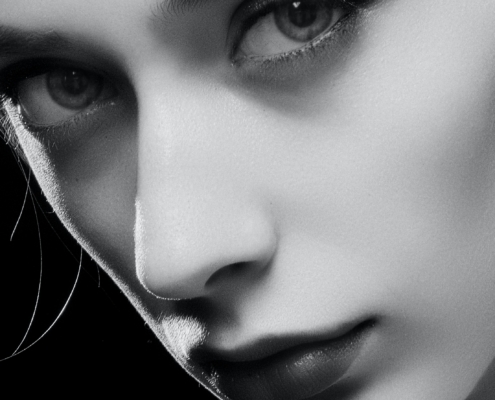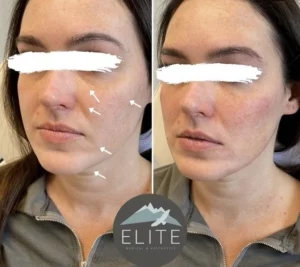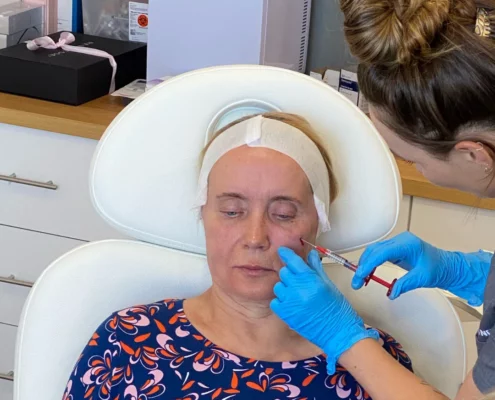Chin Filler 101
/in Fillers /by Ali Wagstaff
Introduction
When most people think of dermal fillers, chin filler is probably not on their minds. But for many clients, precisely injected chin filler gives them the opportunity to enhance the shape and proportions of their chin.
In this article we’ll break down:
- What chin filler is
- What the procedure is like
- How much chin filler costs
- Other commonly asked questions
If you are new to filler injections, in general, read our Filler 101 Guide for more commonly asked filler questions
Table of Contents
What is chin filler?
Chin fillers are dermal fillers injected into the chin with the goal of enhancing the shape, size, or proportion of the chin. It can be done as a single treatment or as a series of injections spaced 2-4 weeks apart, depending how much the chin needs to be built up.
It is a nonsurgical procedure that is not permanent but can last several years. Many clients getting chin fillers hope that the procedure will give them a stronger, more balanced chin.
How much does chin filler cost?
Chin filler cost is mainly dependent on the type of filler used, the amount of filler needed, and where you have the procedure done. For most procedures chin filler will cost between $500-$1500. This is the point where we have to remind you that the most expensive type of filler is the kind you have to have twice. Make sure you pick the right injector, not just the cheapest.
What is chin filler treatment like?
A chin filler treatment is a very quick outpatient procedure that should take an hour or less. The injection portion of the procedure may only be a few minutes. When you get to the office the injector will walk you through the procedure and assess the structure of your face.
After going through any questions you may have, they will carefully select where to place their injections using a needle and syringe or in some cases a cannula. The injections will be done quickly and without much discomfort and after some brief aftercare instructions, you will be on your way to resume your day.
For more insight on what filler appointments are like, read THIS!
Is chin filler painful?
The chin filler procedure can be mildly uncomfortable but tolerable. The mentalis muscle (chin muscle) can be a bit tender, especially afterward because we move the chin so much to talk and eat. The quick pricks with a needle will feel mildly uncomfortable in some areas and sharper in others. Most fillers used for the chin have small amounts of lidocaine to help reduce the discomfort of the injections.
After your procedure, your chin may feel a bit sore and possibly heavier than it usually feels which may make things uncomfortable temporarily while it heals.
What types of filler are used for chin filler?
In general, injectors use a thicker filler for the jaw and chin area to add volume. In most cases, injectors will use a Hyaluronic Acid (HA) filler or a calcium hydroxylapatite (Radiesse) filler “off label” for the procedure. Some of the commonly used fillers are:
To learn more about these fillers, check out our guide on filler.
How long does chin filler last?
Depending on the type of filler injected, and how much was injected, chin filler can last quite a long time, between 10-24 months. At that point, patients will often have the procedure redone to maintain results. They may also come in at regular intervals for touch-ups to maintain the treatment.
What should you do to prepare for chin filler?
Talk to your injecting provider for a complete list of pre-care instructions and things to avoid. In general, it will likely be recommended that you:
- Avoid over the counter blood-thinning medications and supplements like ibuprofen, fish oil, and aspirin (unless these are prescribed for a health condition).
- Read this article on tips to avoid filler bruising and swelling HERE
- Eat pineapple in the week leading up to your treatment if you are nervous about swelling. You can also take Bromelain tablets in the 24 hours before treatment to help reduce pain and swelling.
- Consider taking arnica which will help limit bruising at the injection site.
- Avoid drinking alcohol prior to your treatment. You’ll be unable to consent to the procedure and it may also make your recovery slower by increasing bleeding and bruising.
- Consider limiting the amount of sodium you consume prior to your appointment. Sodium can cause your body to retain more water which will increase your swelling.
- Talk to your injecting provider about any medical conditions or concerns that you may have.
- Show up with a clean, makeup-free face.
What is chin filler aftercare like?
You’ll want to talk to your injector about specific aftercare instructions that may be specially geared to your situation. Most likely, you’ll be able to return to mild activity immediately following your procedure. In general, it will be recommended that you:
- Consider applying an ice pack to the area injected to reduce swelling for the first 24 hours.
- Avoid touching or massaging the area treated.
- Take acetaminophen as directed to alleviate any pain or discomfort. Ibuprofen can delay the healing of bruises or make them worse if present.
- Avoid any heat with the area (places like saunas and hot showers, as well as hot wax) unless instructed to use warm compresses for bruising after the first 24 hrs.
- Consider taking arnica to help reduce any bruising or discomfort.
- Avoid alcohol or exercise for 24 hours afterward to keep down the potential bruising.
If you’re worried about bruising and swelling from filler injections, read our article to learn about ways to reduce this side effect from filler injections, in general.
Is chin filler safe?
Dermal fillers like chin filler are generally very safe when injected by an experienced professional like Ali. Make sure you do your research and read reviews of different injectors before having your procedure done. That being said, any aesthetic procedure comes with inherent risks, talk to your injector about any concerns you may have.
What are the side effects of chin filler?
In the days following your procedure you may experience the following mild side effects from your chin filler injections:
- Redness
- Itchiness at the injection site
- Mild bruising
- Swelling in the area treated
- Soreness
- Possible bone resorption (see below)
If you’ve experienced previous chin filler, or any filler, that you are unhappy with, read how you can fix unwanted filler and start fresh here.
Can chin filler move?
Filler migration in the chin area is rare, but possible. Some injectors will massage filler after injecting it to prevent lumps and make sure that it has accurately treated the area. After your treatment, your injector will most likely advise that you do not touch the area treated and avoid certain activities that may cause it to migrate. Talk to your injecting provider about all possible side effects.
Can chin filler cause bone loss?
A recent study of 80 patients in Asia showed unexpected bone loss of the chin after injections of hyaluronic acid fillers. It was correlated with the amount of filler used. The more filler used, the more bone loss there was. However, there was no change in the aesthetic effect of the chin despite this side effect.
This phenomenon is not seen in other areas of the face like the cheeks or jawline, even when the filler is also injected directly on the bone. There are many theories on why this may happen. Talk to your injecting provider about his risk and all risks associated with aesthetic procedures. It is always best to have an initial consultation, with a provider like Ali, to learn/understand all of the risks and benefits.
Can chin filler fix a weak chin?
Yes, chin filler can be injected in a way that adds definition to the chin and makes it appear stronger. This procedure can help patients that have a small, weak, or receding chins achieve more balance and harmony of their facial profile.
Can filler get rid of a double chin?
Though chin filler will not remove tissue, sometimes the appearance of a double chin may come from the shape and structure of the chin. In these cases filler can be used to reshape the jawline and chin to give it a stronger look.
If there is significant submental fat (fat below the chin) causing the appearance of a “double” chin, then Kybella is a great treatment to do in combination with chin and jawline filler to reduce the extra tissue. See other alternatives below.
Client's before and after chin filler
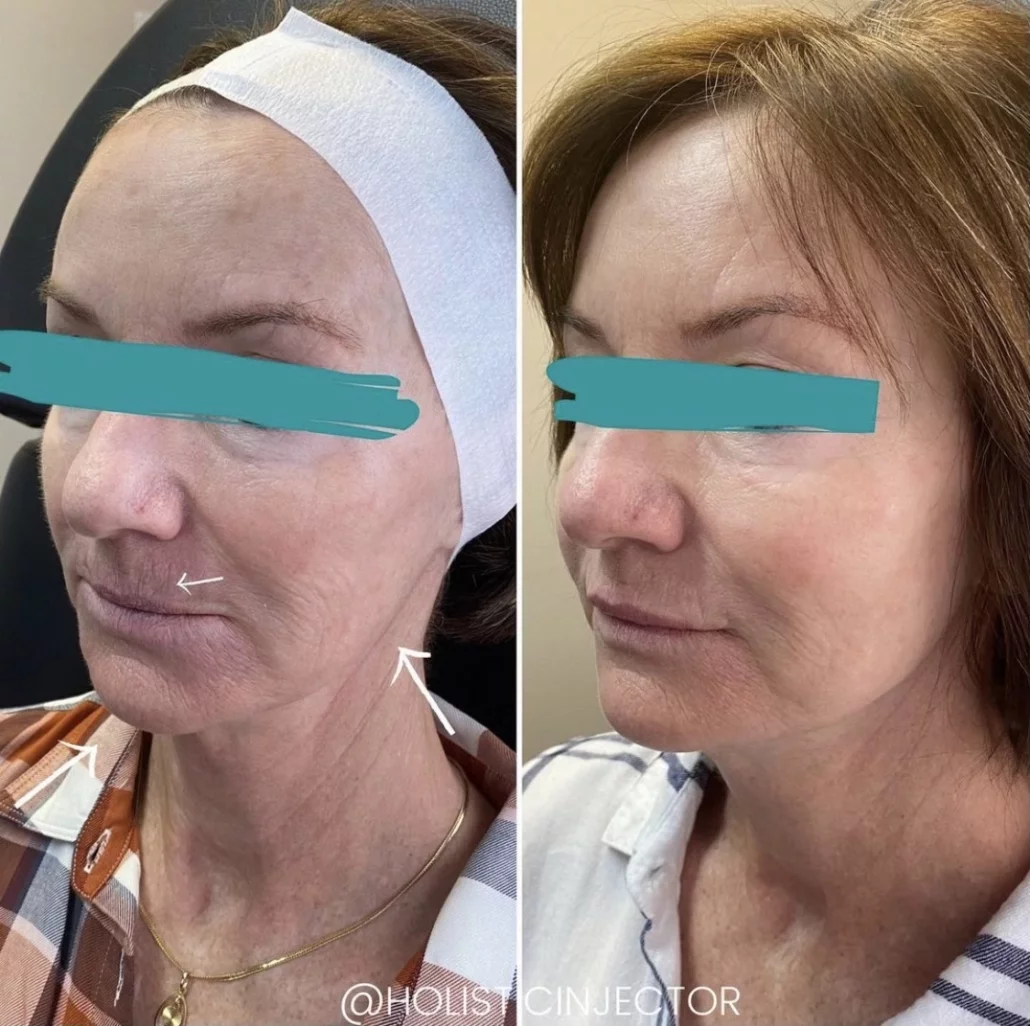
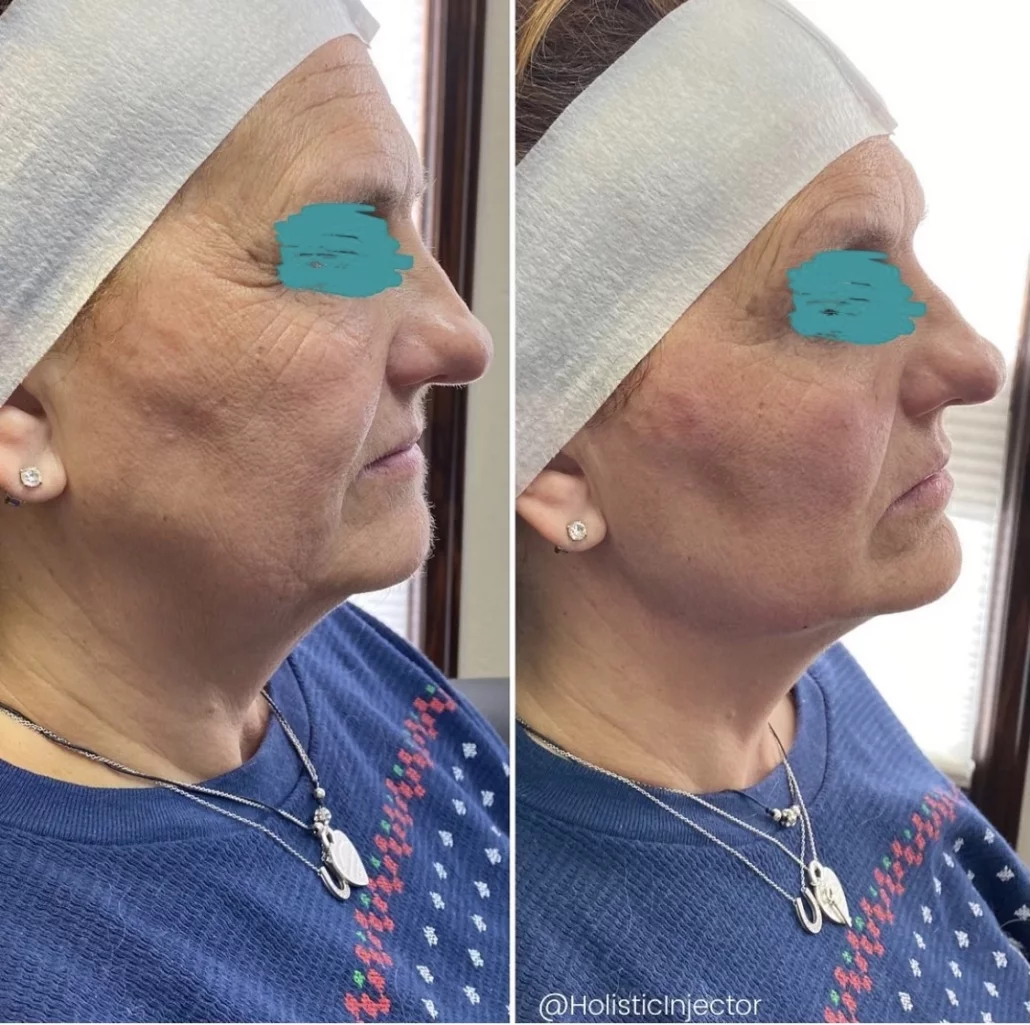
What other procedures are an alternative to chin filler?
Chin implant
What is a chin implant: a chin implant is a surgical procedure where an implant of the desired shape and size is placed in the chin area to enhance this feature.
Cost: $3000-5000
Benefits: This is a permanent procedure where the exact shape and size of the chin can be determined.
Negatives: This procedure requires surgery which always comes with risks and is more expensive than other options.
As above, when an enhanced chin profile is desired it may also be necessary to slim and contour the jawline for best results. This can be accomplished in many different ways but a few treatments often done with chin filler include:
- Kybella/Deoxycholic acid for submental fat or “double chin”. Learn more about Kybella here.
- RF microneedling at deeper depths can tighten the skin and reduce fat. Learn more about RF Microneedling here.
- Jawline and neck liposuction or “facetite” procedure done with a plastic surgeon to suction out versus melt fat along the jawline and below the chin
Is chin filler worth it?
Whether something is “worth it” or not is highly subjective, but we have had immensely positive feedback from all of our chin filler clients. It is one of those areas that is subtle but quite noticeable and can really enhance someone’s look while ensuring they still look like themselves.
If you live near Lone Tree, CO consider coming in for a consultation at Elite Medical & Aesthetics, link below. For more FAQ and Contact information about our practice, read more here.
